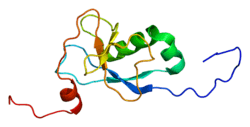DCDC2
Doublecortin domain-containing protein 2 is a protein that in humans is encoded by the DCDC2 gene.[5][6][7]
Function
This gene encodes a protein with two doublecortin peptide domains. This domain has been demonstrated to bind tubulin and enhance microtubule polymerization.[7]
Clinical significance
Mutations in this gene have been associated with reading disability (RD), also referred to as developmental dyslexia.[7][8] But this is controverse since a recent study proposed that there is a "low likelihood of a direct deletion effect on reading skills." [9]
Changes in the DCDC2 gene are frequently found among dyslexics. Altered alleles often occur among children with reading and writing difficulties. The gene appears to have a strong linkage with the processing of speech information when writing.[10][11][12]
References
- 1 2 3 GRCh38: Ensembl release 89: ENSG00000146038 - Ensembl, May 2017
- 1 2 3 GRCm38: Ensembl release 89: ENSMUSG00000035910 - Ensembl, May 2017
- ↑ "Human PubMed Reference:".
- ↑ "Mouse PubMed Reference:".
- ↑ Van Den Eynde BJ, Gaugler B, Probst-Kepper M, Michaux L, Devuyst O, Lorge F, Weynants P, Boon T (Jan 2000). "A new antigen recognized by cytolytic T lymphocytes on a human kidney tumor results from reverse strand transcription". J Exp Med. 190 (12): 1793–800. doi:10.1084/jem.190.12.1793. PMC 2195717. PMID 10601354.
- ↑ Hirosawa M, Nagase T, Ishikawa K, Kikuno R, Nomura N, Ohara O (Jan 2000). "Characterization of cDNA clones selected by the GeneMark analysis from size-fractionated cDNA libraries from human brain". DNA Res. 6 (5): 329–36. doi:10.1093/dnares/6.5.329. PMID 10574461.
- 1 2 3 "Entrez Gene: DCDC2 doublecortin domain containing 2".
- ↑ Lind PA, Luciano M, Wright MJ, Montgomery GW, Martin NG, Bates TC (June 2010). "Dyslexia and DCDC2: normal variation in reading and spelling is associated with DCDC2 polymorphisms in an Australian population sample". Eur. J. Hum. Genet. 18 (6): 668–73. doi:10.1038/ejhg.2009.237. PMC 2987340. PMID 20068590.
- ↑ The DCDC2 deletion is not a risk factor for dyslexia | Peer reviewed| Date of acceptance: 2017-06-13| https://ora.ox.ac.uk/objects/uuid:812610e3-4d0e-41a9-8c73-6109e677f5ee
- ↑ Meng H, Smith SD, Hager K, Held M, Liu J, Olson RK, Pennington BF, DeFries JC, Gelernter J, O'Reilly-Pol T, Somlo S, Skudlarski P, Shaywitz SE, Shaywitz BA, Marchione K, Wang Y, Paramasivam M, LoTurco JJ, Page GP, Gruen JR (November 2005). "DCDC2 is associated with reading disability and modulates neuronal development in the brain". Proc. Natl. Acad. Sci. U.S.A. 102 (47): 17053–8. doi:10.1073/pnas.0508591102. PMC 1278934. PMID 16278297. Lay summary – Sciencedaily.
- ↑ Schumacher, J.; Anthoni H.; Dadouh F.; et al. (Jan 2006). "Strong genetic evidence of DCDC2 as a susceptibility gene for dyslexia" (PDF). The American Journal of Human Genetics. 78 (1): 52–62. doi:10.1086/498992. PMC 1380223. PMID 16385449. Archived from the original (PDF) on 2013-05-15.
- ↑ Marino C, Meng H, Mascheretti S, Rusconi M, Cope N, Giorda R, Molteni M, Gruen JR (February 2012). "DCDC2 genetic variants and susceptibility to developmental dyslexia". Psychiatr. Genet. 22 (1): 25–30. doi:10.1097/YPG.0b013e32834acdb2. PMC 3232293. PMID 21881542.
Further reading
- Nakajima D, Okazaki N, Yamakawa H, et al. (2003). "Construction of expression-ready cDNA clones for KIAA genes: manual curation of 330 KIAA cDNA clones". DNA Res. 9 (3): 99–106. doi:10.1093/dnares/9.3.99. PMID 12168954.
- Strausberg RL, Feingold EA, Grouse LH, et al. (2003). "Generation and initial analysis of more than 15,000 full-length human and mouse cDNA sequences". Proc. Natl. Acad. Sci. U.S.A. 99 (26): 16899–903. doi:10.1073/pnas.242603899. PMC 139241. PMID 12477932.
- Mungall AJ, Palmer SA, Sims SK, et al. (2003). "The DNA sequence and analysis of human chromosome 6". Nature. 425 (6960): 805–11. doi:10.1038/nature02055. PMID 14574404.
- Gerhard DS, Wagner L, Feingold EA, et al. (2004). "The status, quality, and expansion of the NIH full-length cDNA project: the Mammalian Gene Collection (MGC)". Genome Res. 14 (10B): 2121–7. doi:10.1101/gr.2596504. PMC 528928. PMID 15489334.
- Meng H, Smith SD, Hager K, et al. (2006). "DCDC2 is associated with reading disability and modulates neuronal development in the brain". Proc. Natl. Acad. Sci. U.S.A. 102 (47): 17053–8. doi:10.1073/pnas.0508591102. PMC 1278934. PMID 16278297.
- Schumacher J, Anthoni H, Dahdouh F, et al. (2006). "Strong genetic evidence of DCDC2 as a susceptibility gene for dyslexia". Am. J. Hum. Genet. 78 (1): 52–62. doi:10.1086/498992. PMC 1380223. PMID 16385449.
- Brkanac Z, Chapman NH, Matsushita MM, et al. (2007). "Evaluation of candidate genes for DYX1 and DYX2 in families with dyslexia". Am. J. Med. Genet. B Neuropsychiatr. Genet. 144 (4): 556–60. doi:10.1002/ajmg.b.30471. PMID 17450541.





